This September and October, we’re taking a look at the jam-packed 1994 to 1995 season of Star Trek, including Star Trek: Deep Space Nine and Star Trek: Voyager. Check back daily for the latest review.
So, Star Trek: Voyager.
Where do we begin? Voyager is probably the most divisive and controversial of the Star Trek spin-offs, the one that carries a lot of the blame for the franchise’s decline and decay in the mid to late nineties. It is the series that connects the tail end of the success story that was Star Trek: The Next Generation to the start of the dying gasp that was Star Trek: Enterprise. This spin-off had the misfortune to launch at the height of a revived franchise’s popularity and to finish as public interest waned.
Star Trek: Voyager felt like an act of hubris. It was positioned by Paramount to be the studio’s highest-profile television show. It was a feature of the television landscape, finally allowing Paramount the chance to leverage its own television network – a plan delayed since the late seventies, but deemed feasible in the mid-nineties. UPN branded itself “the first network of the new century”, a rather arrogant declaration. Caretaker was the first thing broadcast on UPN in early 1995, débuting to an audience of more than 21 million. However, Voyager would never reach those figures again.
Despite that success, things fell apart quickly. None of the shows that aired on UPN’s second night received a second season. The only shows to limp on to renewal from the network’s rocky first year were Voyager, The Sentinel and Moesha. Of these meagre freshmen hits. Voyager lasted the longest, with one more season to its name than Moesha. Over the summer of 1995, it was identified by The Los Angeles Times as the network’s “star survivor”, and the show upon which all of the network’s hopes rested. By 2000, five years later, the network had run up a debt of $800,000.
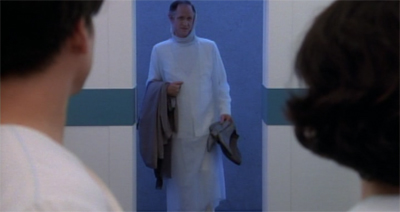
“I hope you don’t mind, our tailors measured you while you were unconscious. It’s all part of a standard probe.”
That’s a lot of pressure for any television series to bear. Following (and, in the eyes of many, replacing) an illustrious predecessor, supporting the weight of a new television network, pushing into the future while remaining anchored to the past, it’s no wonder that Star Trek: Voyager wound up the confused mess that it became. Indeed, one can recognise many of the problems that would haunt the show through to its final season tied up in this pilot episode.
Voyager remains a hotly contested issue among Star Trek fans, although that’s probably not a surprise – Star Trek fans can turn just about anything into a hotly contested issue. What is Voyager? Ask a dozen people and you’ll get a dozen answers. Is it a clever (and misunderstood) commentary and critique of the franchise as a whole? Is it the first truly feminist Star Trek? Is it even Star Trek at all?
These are all rather strong and divisive readings; I don’t subscribe to any of them in their entirety. And yet, re-watching Caretaker, it is quite difficult to properly contextualise and understand Voyager. It was produced at a time when Star Trek seemed on the verge of cultural recognition. This was really the climax of Star Trek‘s return to prime time television, airing within the same year of the end of The Next Generation, the release of Star Trek: Generations and the third season of Star Trek: Deep Space Nine.
The last season of The Next Generation had even got an Outstanding Drama nomination at the Emmys. Around the same time that Voyager first aired, news broke about plans to build Star Trek: The Experience in Las Vegas. In fact, Voyager had enough clout to actually sign Oscar-nominated actress Geneviève Bujold to headline the series. That didn’t work out, and second choice Kate Mulgrew was brought in to head the ensemble.
And so Caretaker has a lot of confidence, bordering on arrogance. It opens with scrolling text and space ships chasing one another, a conscious attempt to evoke the big budget grandeur of Star Wars. (There are even rebels fleeing an evil empire, to underscore the point.) All of this is a tad over-blown and unnecessary. The exposition could easily have been delivered by Janeway in the next scene.
Never mind that the scroll text assumes that audiences care at all about (and are aware of) “the Federation and Cardassia”, despite the fact that only one Cardassian appears in the entire episode. The teaser features showy action and nice special effects, but it’s bogged down with techno-babble nonsense about “plasma fields” and “re-routing” energy from one piece of tech to another. It is effective at what it sets out to do, but it seems to wallow in the tropes and conventions of contemporary Star Trek.
This is most obvious in the treatment of Voyager itself. The opening credits are stunningly rendered, and utter majestic, but they almost play like a car commercial for a space ship – watch Voyager plow through space dust fields! marvel as Voyager hits top speeds of over warp 9! it looks beautiful to any local planetoids, and is a joy to handle! The episode basks in how impressive this fictitious starship actually is.
Encounter at Farpoint opened with Picard already on board the Enterprise and heading towards the eponymous base. It was only seven years later, after the show became a success, that we can to see Picard coming on board his ship. In Emissary, Terok Nor is a disaster zone, with set, production and sound design conveying that this isn’t meant to be a sleek Federation vessel. In Caretaker, we get Tom Paris’ first view of Voyager (which comes after we’ve already seen it in the opening credits), with a sequence intended to revel in the ship’s design.
“Intrepid class,” Stadi helpfully explains, as if talking Paris through some futuristic showroom. “Sustainable cruise velocity of warp factor nine point nine seven five. Fifteen decks. Crew complement of one hundred and forty one. Bio-neural circuitry.” It’s worth noting that very few of these make any real difference to the show as it goes on – the crew seems to be filled with expendable individuals, Voyager’s only ever as fast as the plot requires, and the “bio-neural circuitry” is used as a macguffin in precisely one of the show’s future episodes, Learning Curve.
It’s clear that Caretaker is trying to recreate that iconic moment where Kirk first views the Enterprise in Star Trek: The Motion Picture. That’s understandable. It’s a pretty essential piece of Star Trek iconography, so much that even JJ Abrams revisited it when rebooting Star Trek in 2009. However, it feels a little bit too much like Caretaker is basking in its own importance, without any real substance.
Of course, the show’s opening credits are rather troublesome of themselves. On top of undermining the majesty of Paris’ approach to Voyager, they also effectively “spoil” any real surprise at how the crew shapes up. The fact that Chakotay, Tuvok and Torres are all listed makes it clear at how this ensemble is going to form. The fact that Stadi, Cavit and real!Doctor are not makes it clear that they will be dead by the end of the episode. Deep Space Nine at least made a point to conceal the wormhole during the credits to Emissary.
This sets an unfortunate precedent for the show. Voyager would ultimately define itself as a show terrified about upsetting audience expectations or doing anything vaguely controversial. It was a show dedicated to following the path of least resistance. This manifested itself in a number of ways, many of which would become quite obvious over the course of the first season. But let’s talk about Caretaker for a moment.
On the surface of it, Voyager has a very diverse cast. The captain is a woman; the first officer is a Native American; the operations officer is Asian. Even the aliens are diverse. Tuvok is a Vulcan played by an African American; Torres is half-Klingon, but her human half is latina. It feels like it continues the trend set by Deep Space Nine of featuring a diverse ensemble, with a particular emphasis on the female captain.
One gets a sense that the show is acutely aware of this. Most of the guest cast killed over the course of the plot are white men. First officer Cavit, the dead human doctor and Rollins all die at their posts. Although there are three white men in cast, one of them is buried under latex as Neelix and the other portrays a hologram. Only Robert Duncan McNeill is a white American man playing a white American man.
So, by rights, Caretaker should feel like a celebration of diversity, right? Unfortunately, not. Despite the fact that the show has a wonderful diverse central cast, Caretaker is very clearly built around the one white male American character in the group. Michael Piller conceded as much in Visions of the Future:
The second hour always seemed to dog us. The biggest danger in the pilot was in creating a story that nobody cared about. Instead of taking the approach I took with Deep Space Nine, I felt this time the audience was ready for a slam-bang action adventure. So we spent less time on any individual character, which in a way would have been easier to write because you really get into the meat of the characters. Instead, we played the adventure off the family. So the only true character arc in this show is Paris’.
Though the show opens with Chakotay’s abduction, Paris gets the show’s first dialogue-heavy scene. His character and history are laid out rather effectively as Janeway recruits him for the mission. It’s through Paris’ eyes that we first see Voyager itself.
The episode is structured as Paris’ redemption. He begins the episode as a convict and ends as a hero. Paris is the character who volunteers for the mission to rescue Harry Kim. It’s Paris who leads the team that gets Harry and B’Elanna to the surface. It’s Paris who goes back for the second team. Paris takes the helm, earns Chakotay’s respect and the episode ends with Janeway affording him a field commission and crew position.
Star Trek pilots are traditionally built around the lead performer in the ensemble. The Cage is about Christopher Pike getting over his lingering doubt and guilt. Where No Man Has Gone Before is about the death of James T. Kirk’s best friend. In Encounter at Farpoint, it’s Picard who stands up to Q. Emissary is about Sisko finding the will to lead and explore again. Even Broken Bow is about Archer trying to work past his bitterness towards Vulcans and taking his ship on his first mission.
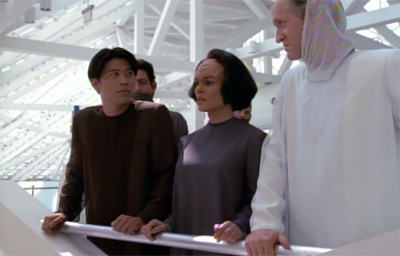
“You can have robes like mine once you’ve proven you can handle the ketchup at the food court properly.”
As such, it feels a little uncomfortable that so much of Caretaker unfolds from the perspective of its only white male American character. His middle name is even “Eugene”, in a nod to Star Trek creator Gene Roddenberry. It’s worth noting that Tom Paris would be one of the handful of Voyager characters to actually get a character arc spanning the series, and whose character development by Endgame involves a bit more than the sentence “… is now seven years older.”
However, even Caretaker‘s handling of Tom Paris feels a little awkward – as if the series is following the path of least resistance. By all accounts, Paris is modeled on the character of Nicholas Locarno from The First Duty. The character was also played by Robert Duncan McNeill and has a similar history. “Was the accident my fault?” Tom asks, rhetorically, while recalling the event. “Yes. Pilot error. But it took me a while to admit it.” It’s quite similar to how that episode played out.
As Visions of the Future explains, many early documents referred to the character as “Locarno.” It’s unclear why exactly the character was changed. It has been suggested that using Locarno would have involved paying royalties to creators Naren Shankar and Ronald D. Moore. In an interview with Starlog, McNeill suggested it was a creative decision:
“They wanted a character with a little more colourful background, and they wanted to have it be a little more open, rather than have him be locked into that accident. Actually, there are several reasons,” he notes. “They wanted him to come from a family of high-ranking Starfleet officers and have him screw up left and right. So, there’s that pressure of living up to his family’s history.
“They also felt that the way that Locarno came off in that episode didn’t really open the door for the character on Voyager. He came off as a bad guy, not a nice guy, and they didn’t want this character to be a bad guy. They wanted him to be a basically decent guy who got into a lot of trouble.”
And perhaps that’s the problem. For all that Tom Paris presents himself as a rogue, Caretaker does little to establish him as such. In fact, it sounds like Paris protests a bit too much. Unlike Locarno, he owned up to his screw-up, rather than facing an investigation. He goes back for Harry (and later even Chakotay) without hesitation. In fact, he even made a pretty crappy rebel. “I was only with the Maquis a few weeks before I was captured, Captain,” he explains.
It doesn’t help that Caretaker ends with most of his major conflicts resolved. Cavit and the human doctor seem to be the only characters on Voyager who have a problem with Tom Paris serving on the ship; both are conveniently killed by the Caretaker. Chakotay has a history of animosity against Paris, but that is handily resolved when Paris gets to go back and save Chakotay’s life. Chakotay even promises to serve as Paris’ “bodyguard”, against possible fallout that we never get to see.
There’s absolutely no indication, at the end of Caretaker, that Paris will be treated by the show as anything other than a generic Star Trek lieutenant. The show does briefly return to the idea in the second season, but it’s very much too little too late. (And too poorly handled.) There’s no sense of a lingering conflict here. Even Chakotay seems ready to forgive Tuvok for spying on him and the Maquis as a whole. You would imagine that somebody would resent Tuvok’s actions, but it’s never really broached.

Two of these characters will not survive. Also, two of these characters are not in the main cast list.
Still, Caretaker makes it quite clear that is an attempt to get back to the classic model of Star Trek, as embodied by the original series. In an interview with The Los Angeles Times before the launch of the show, Piller expressly stated this was a back to basics approach:
“Space has become very crowded in the Star Trek universe over the last 25 years – with Klingons, Romulans, Vulcans and the whole gang in the Alpha Quadrant,” Piller said. “But the original intent of [Star Trek creator Gene] Roddenberry was to have a ship alone out there in the unknown. In a sense, we’re going back to basics with a real adventure show again, with none of the familiar aliens to trouble us, and a whole bunch of new ones.”
This is reflected by Caretaker in a number of ways, quite a few are troublesome. The focus on episodic adventures over long-term story-telling is one example, but there are other more problematic results of this shift in focus.
It’s quite clear that Caretaker is returning to Roddenberry’s classic model of Star Trek – essentially a western set in space. It’s no coincidence that the first world that our heroes stumble across is a desert planet. Asked why anybody would live in a place like this, Neelix helpfully explains that the mining is profitable. “The rich cormaline deposits are very much in demand.” Even outside the surface of a desert planet, it is revealed that water is very much in demand. Neelix has never had a bath. This is a very technologically primitive part of the galaxy.
It’s not worth thinking too hard about the logical problems that arise from all this. The Kazon have mastered warp drive, but conveniently not transporters or replicators? Despite the fact that the Kazon keep pace with Voyager for over two years, and Neelix remains a travel expert for longer, how come nobody thought to simply export water from one of the numerous water-filled worlds that Voyager visits between now and Basics, Part II? Again, there’s a sense that Caretaker is more about mood than about logical sense.
However, pairing up this “civilised ship in an uncivilised corner of the galaxy” set-up with the focus on Tom Paris as a white American protagonist, makes Caretaker just a little bit awkward. The Kazon are an uncomfortable creation. They were described in early production documents as akin to gangs. It is later revealed that they used to live as slaves, and it’s suggested that the entire Delta Quadrant rued the day that they earned their freedom. Seven of Nine later dismisses them as too primitive to be worthy of assimilation.
In the context of a frontier narrative, the Kazon read like an incredibly racist creation – a bunch of primitives with dark skin living in the desert and existing as an obstacle to our heroes. The attempt at commentary on Los Angeles gangs only compounds the issue, with all the unfortunate racial profiling that went into coverage of gang activity in Los Angeles during the nineties coupled with a history of slavery that makes it seem like they were constructed for analogues for a particular ethnic group. (It is worth conceding that Deep Space Nine also awkwardly waded into the racial issues surround gangs in The Abandoned.)
It’s very clear from the outset that Voyager is running on some of the more awkward and outdated Star Trek clichés, particularly when it comes to the portrayal of alien races. When Quark provides the obligatory cameo to send Voyager on its way, Harry Kim remarks, “We were warned about the Ferengi at the Academy.” This is very much in keeping with the morality and relativism espoused by The Last Outpost and other Next Generation episodes that presented the Ferengi as evil for being capitalist. And – although Quark kicks up a fuss about the “warning” – Caretaker makes it clear that Kim was right; he should have been “warned.”
Many of the perceived problems with Voyager are rooted in the way that the show tries to throw itself back to the classic Star Trek. The lack of long-form storytelling, for example, is a trait of the classic Star Trek. On the classic television show, Kirk could be just as erratically written as Janeway would be in the years ahead, but the difference being that Shatner’s performance was a lot more “fun” than Kate Mulgrew’s. The problem was that these sorts of nostalgic throwbacks already felt outdated on a television show in the nineties, and seemed actively at odds with Voyager‘s “we’re trying to get home” overarching plot.
Despite the return to the classic “outer-space-as-the-Wild-West” set up from the original Star Trek, Voyager immediately establishes itself as a show built around contemporary American concerns. The first few seasons are built around the idea that the Delta Quadrant is less advanced than Voyager, casting Janeway and her ship in the role of peace-makers and peace-keepers during the initial leg of their journey through the Delta Quadrant.
This is roughly in keeping with how America saw its own global responsibilities in the mid-nineties. With the collapse of the Soviet Union, there was no power block that could challenge the United States in military or political terms. The country spent most of the nineties trying to maintain global peace and control small-scale conflicts among smaller and less powerful nations. Humanitarianism and limited military intervention were instruments of foreign policy.
Pundit Charles Krauthammer described it as “the unipolar moment”, the period of time where America would be the dominant force in global affairs. As Krauthammer wrote in The Unipolar Moment Revisited, this role carried responsibilities:
The new unilateralism defines American interests far beyond narrow self-defense. In particular, it identifies two other major interests, both global: extending the peace by advancing democracy and preserving the peace by acting as balancer of last resort. Britain was the balancer in Europe, joining the weaker coalition against the stronger to create equilibrium. America’s unique global power allows it to be the balancer in every region. We balanced Iraq by supporting its weaker neighbors in the Gulf War. We balance China by supporting the ring of smaller states at its periphery (from South Korea to Taiwan, even to Vietnam). Our role in the Balkans was essentially to create a microbalance: to support the weaker Bosnian Muslims against their more dominant neighbors, and subsequently to sup- port the weaker Albanian Kosovars against the Serbs.
In many respects, this is the sort of situation that Janeway finds herself in during the early days of her visit to the Delta Quadrant – she’s dealing with squabbling factions and low-scale crises that require Voyager to balance and rectify.
That comes into play in Caretaker, where Voyager is forced to act as a “balancer” in the conflict between the Kazon and the Ocampans. As Tuvok explains, this violates the classical understanding of the Prime Directive – the Federation’s solemn vow of non-interference. “Captain, any action we take to protect the Ocampa would affect the balance of power in this system,” Tuvok assures her. “The Prime Directive would seem to apply.” Janeway doesn’t seem convinced by his logic. Her concerns are more humanitarian. “Would it? We never asked to be involved, Tuvok, but we are. We are.”
It’s a heavy weight that lies on Janeway’s shoulders. Again, there’s a sense that Caretaker works better at mood than plot. The moral dilemma at the climax asks Janeway to choose between going home and turning her back on suffering, or doing the right thing and trapping her crew. It seems like nobody ever heard of a time bomb or a countdown, or even the possibility of firing a torpedo at the instant Voyager is hurled home. These ideas are never raised or discussed, and Caretaker is more intrigued with the issues that it has raised than with the logic of implementing them.
To be entirely fair, the script does try to pre-emptively defuse any of these solutions. As the crew weigh their options, Tuvok observes, “Captain, I can access the system to send us back to Federation space, but it will take several hours to activate.” So you could argue that using the array to return home was never an option. That said, there is an alternative. Janeway immediately notes that the Caretaker could send them home much quicker. There’s no reason they couldn’t try to reach an agreement in his last moments.
That said, even if Tuvok’s statement is to be taken at face value, it undercuts any dramatic tension and the moral weight of the story. If Janeway doesn’t make an active choice to protect the Ocampa, if she is just a passive observer in all of this, then it undercuts all her rhetoric about how Voyager needs to be governed by higher ideals; Janeway can’t act like it is a choice if it was the only possible outcome. Even later episodes of Voyager – like Night – seem to acknowledge this, starting from the assumption that it was a moral choice that stranded Voyager in the Delta Quadrant. The problem is that Caretaker never gives that substance.
In a way, that’s probably the biggest single problem with Caretaker as a two-hour event. At the end of the adventure, everything seems to be hunky-dory. Everything is tidied up. The ship has set a course for home, and will hope to get there in less than seven decades. It seems like everybody knows their place. Everybody belongs as part of the crew already. The Maquis are in Starfleet uniforms at this point, with only little insignia on their collar to distinguish them.
“That’s why Commander Chakotay and I have agreed that this should be one crew,” Janeway explains in he closing monologue. “A Starfleet crew. And as the only Starfleet vessel assigned to the Delta Quadrant, we’ll continue to follow our directive to seek out new worlds and explore space.” But why? What’s the reason? Has everybody agreed to be governed by Starfleet rules? Has everybody agreed that you’re best suited to wandering aimlessly from anomaly to anomaly, planet to planet, instead of just plotting a straight line from home?
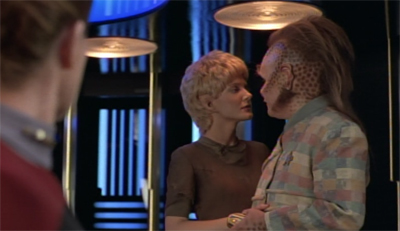
I still question the decision to make the show’s first alpha couple a three-year-old girl and a Neelix…
Is exploration a higher priority than sustainability? Surely priorities must be different on this journey? Starfleet regulations seem unlikely to have been written for this sort of long-term journey, so why are you just assuming that they are still applicable? Particularly after you just broke the Prime Directive to do the right thing and help the Ocampans? There are lots of big questions here, and lots of questions that might potentially explore the limits of Star Trek could be. Is Star Trek still Star Trek if it has a destination? Is Star Trek still Star Trek is survival is more important than exploration?
Unfortunately, Voyager is not interested in exploring the limits of what Star Trek can be. It’s not the younger sibling in the same way that Deep Space Nine was, and so it lacks the freedom to push the boundaries. Voyager is a show that seems to have the fate of an entire network leaning on it. That means the network wants a safe bet. It wants something that has worked before. It wants a redux of The Next Generation, essentially.
All of which is fine, but it wastes one fascinating premise. When Q threw the Enterprise into the Delta Quadrant in Q Who?, he teased that it was “wondrous, with treasures to satiate desires both subtle and gross, but it’s not for the timid.” It contained something utterly unlike anything the franchise had ever seen before. Now, it all seems far too familiar, home to familiar clichés and stock set-ups. As we’ll see, even the Borg themselves have become far too familiar.
Caretaker might be the most expensive episode of Star Trek ever filmed, and it might have launched the UPN network, but the cracks are already showing.
You might be interested in our other reviews from the first season of Star Trek: Voyager:
- Caretaker
- Parallax
- Time and Again
- Phage
- The Cloud
- Eye of the Needle
- Ex Post Facto
- Emanations
- Prime Factors
- State of Flux
Filed under: Voyager | Tagged: caretaker, delta quadrant, desert, kathryn janeway, review, star trek: voyager, Television, tom paris, upn, voyager |

















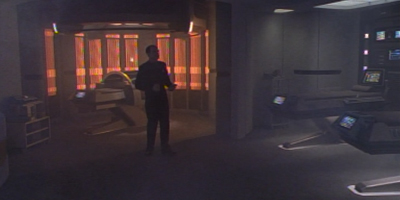

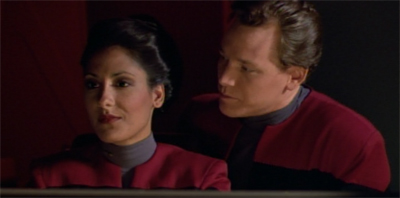

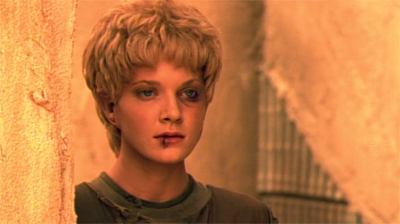
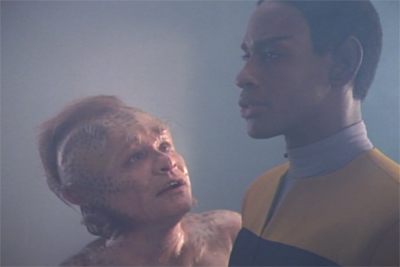



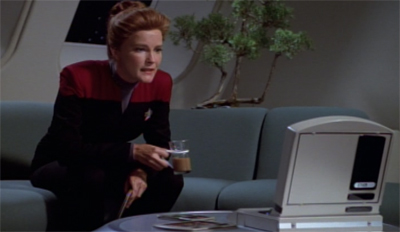
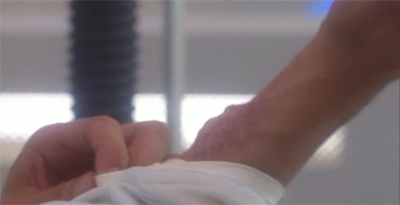

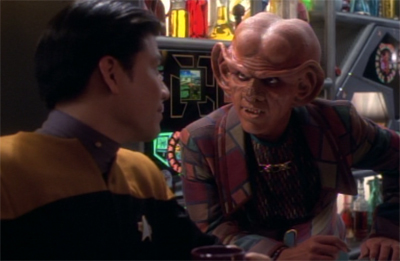
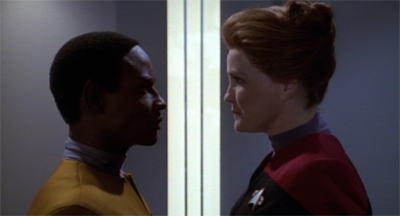

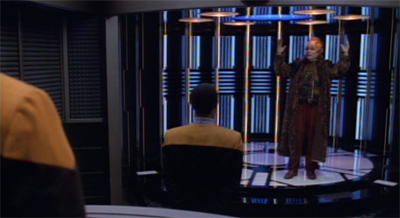
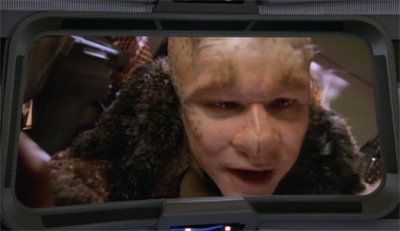
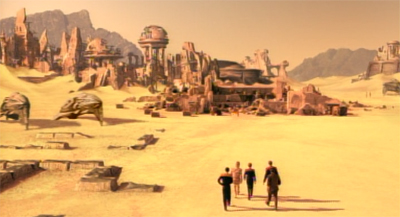





“All of which is fine, but it wastes one fascinating premise. When Q through the Enterprise into the Delta Quadrant in Q Who?, he teased that it was “wondrous, with treasures to satiate desires both subtle and gross, but it’s not for the timid.” It contained something utterly unlike anything the franchise had ever seen before. Now, it all seems far too familiar, home to familiar clichés and stock set-ups. As we’ll see, even the Borg themselves have become far too familiar.”
Well… it’s not even “utterly unlike” the past of the franchise. As you said in that review, the Borg and that snapshot of the Delta Quadrant were more of a throwback to the first season of TOS, when space was full of mysteries and anomalies and lost civilizations and beings that weren’t just humans in makeup… and in general, actually, really alien things, before the show started world-building that part of space into something more familiar with the Klingons and Romulans and Vulcans.
Not that there would have been anything wrong with bringing back that kind of Trek: but even then, it wouldn’t have been really “new,” just going back to the basics. Which is kind of the story of Voyager in a nutshell. There’s nothing there that hasn’t been done before.
Very good point, actually.
It does seem in the first season like the show wants to be back to a very classic TOS version of Star Trek, a much more archetypal “Western adventuring in space” than the later years of The Next Generation or any of Deep Space Nine. The early shows in particular have a short of B-movie feel to them (like Phage or Faces), and play on Western clichés (Emanations even features a burial ground, and the Kazon are stereotypical “primitives”). While it didn’t really work, it was perhaps a lot more interesting that the TNG-lite that the show was already becoming by early in the first season.
There seems to be some truth in this.
I read a disquieting thing on Doc Oho’s excellent blog about Deep Space Nine – that it was Trek in name only. This was coming from a fan, mind you. Just as Moore’s later work on BSG held virtually no connection with the source material, DS9 was a unique property (Babylon 5 notwithstanding) hiding under the veneer of a big one.
It seems that with the glut of sci-fi television in the mid-nineties, there was nothing Trek could attempt that wasn’t done before, and better; either by itself or by its many imitators. Babylon 5 skewered the notion of a lily-white, homogenous, utopian future. Farscape was borderline experimental in cinematography and narrative – on par with Russel T. Davies. SG-1 was the new Star Trek for a jaded and Trope-aware audience. (The latter was the final nail in the coffin for Trek, as far as I and see. The franchise can only appeal now to sentimentalists and shippers.) Even Firefly, which cast the Maquis as heroes and the monolithic Federation as an insidious police state, deserves some credit for furthering the genre.
These are huge hurdles to be overcome. Even if Voyager had been brilliant on a regular basis, it would have to transmogrify into something unrecognizable to be truly new.
It’s a fair point.
That said, I’m not entirely convinced by the DS9 is not Star Trek view. I think, rewatching TOS, that DS9 is pretty much Gene L. Coon’s version of Star Trek. It’s a show that doesn’t take itself too seriously – for better or worse – and also doesn’t buy wholeheartedly into the idea that massive bureaucratic organisations are likely to ever produce utopia.
(I also think that DS9 works best in the context of Star Trek as the younger brother of TNG. I don’t think you get the full effect unless you can see what DS9 is rebelling against. I think DS9 without the context of twenty-five-plus years of Star Trek would be a very different show. But that’s definitely something that exists outside the narrative – although I think that Behr and company really did fetishise TOS more than anybody who has ever run a Star Trek show except for Manny Coto.)
But you make a very good point about how shows around VOY and ENT were probably better at pushing the idea of what you could do with these framework ingredients than the Star Trek franchise itself.
Great article, in depth, and I definitely agree with the UPN analysis. Sad but true.
That said… I feel Voyager eventually was able to stand on its own. Sure, it suffers from the same problems Star Trek has always suffered (aka, director specific peculiarities, writer stories, etc…), but in its own way I feel it was able to stand its own. I actually reached TNG season 7 the other day and switched to Voyager because it was more interesting to me. Quite a feat for Star Trek…
Thanks Sam.
I’m the rare Star Trek fan who actually doesn’t mind TNG S7. It’s definitely over the hill, and there’s a faint scent of desperation to it all, but there is a certain fun “throw everything at the wall and see what sticks” approach to it. I know it’s not consistently good television or anything like that, but I prefer it to a lot of Voyager. (Although I’ll always have a soft spot for S3/S4 Voyager.)
Kes is 1yr old at this point Darren, but that’s even more disturbing. Rollins survived the trip to the Delta Quadrant, but inexplicably vanished after Caretaker. Was Q Who set in the Delta Quadrant or a distant region of the Alpha Quadrant?
I thought it was the Delta Quadrant in Q Who? But not sure.
Looking up Memory Alpha, I like that Rollins’ biggest contribution beyond Caretaker is objecting to Tom Paris’ punctuation.
I don’t think the quadrant system was even created at that point. I’m pretty sure at that time it was just some nebulous distant region of the galaxy.
AFAIK the concept of the Alpha, Beta, Gamma and Delta Quadrant is introduced in a TNG episode in the fourth (I think?) season involving Ferengi and a wormhole (that got a follow up in Voyager). I can’t remember the name though. And from what I’ve read, I believe they originally intended the region in “Q, Who” to be the Gamma Quadrant, since the Borg were the original planned villains of Deep Space Nine, and Voyager wasn’t written with them in mind.
And after they were rejected for DS9 (for being too much of an uber villain) and after they felt Voyager needed a good villain after the failures with the Kazon, etc they drop that line about the Delta Quadrant in First Contact to get them into Voyager. At least, if I remember it all correctly.
The episode was The Price in TNG’s third season about the distant Gamma and Delta Quadrants; Picard estimated that without the use of a wormhole it could take up to 80yrs to reach there at warp 9. I didn’t know the Borg were originally intended to be DS9’s arch nemesis before arriving at the Dominion (is that why they appeared in Emissary in flashback before vanishing altogether?).
Caretaker isn’t a bad episode per second, it’s well cast (particularly Kate Mulgrew) and elevated by Winrich Kolbe’s dependable direction, but your criticism is pretty sound. What’s the point of opening with a text scroll about the Cardassian DMZ in a show in the Delta Quadrant?
Definitely the weakest of the Trek pilots. Though DS9 is my favorite Trek, I have a soft spot for Encounter at Farpoint as far as the pilots go.